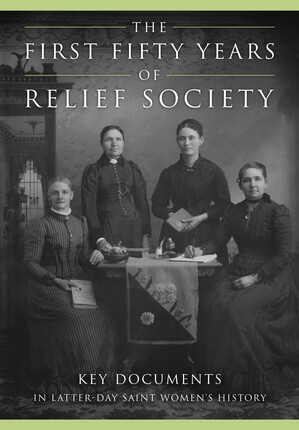The following is an excerpt from the Church's groundbreaking new book focusing on women's history, The First Fifty Years of the Relief Society.
Protecting Their Rights
On March 2, 1886, the Deseret Evening News announced that a mass meeting would be held four days later in Salt Lake City “for the purpose of making known the grievances of the women of Utah, and protesting against the indignities that have been heaped upon them in the present anti-‘Mormon’ crusade.”
These Latter-day Saint women met to protest the Edmunds Act, a federal statute signed into law in March 1882 that disenfranchised participants in plural marriage, created a new category of crime for “unlawful cohabitation” to make prosecutions for polygamy easier, and provided for fines and imprisonment for participants in plural marriage. Increasingly rigorous federal enforcement of the Edmunds Act caused intense tumult in territorial Utah. As one legal historian explains, “By the mid-1880s the territorial courts were awash in indictments, arraignments, trials, and appeals. The gradually accelerating pace of legal process defined the course of events in Utah, affecting all aspects of life.”
The women’s protest was also directed at the Edmunds-Tucker Bill then pending in Congress, which proposed to take even more drastic measures to end plural marriage than had the Edmunds Act. When this bill became law in 1887, it placed most of the church’s property and financial holdings into receivership and disenfranchised all Utah women regardless of church membership or any participation in plural marriage.
On the afternoon of Saturday, March 6, 1886, an estimated two thousand individuals, including some men, assembled for the protest meeting in the Salt Lake Theatre. The meeting consisted primarily of addresses by Latter-day Saint women and the formal adoption of nine resolutions. Among other things, the resolutions objected to the proposed repeal of Utah women’s right to vote under the Edmunds-Tucker Bill, the prosecution of antipolygamy laws in the district courts, and the compelling of wives to testify against their husbands.
The ninth resolution called upon the women of the United States to “come to our help in resisting these encroachments upon our liberties and these outrages upon our peaceful homes and family relations.” A month earlier, the Woman’s Exponent reprinted a January 1886 article from the Woman’s Journal, the newspaper of the American Woman Suffrage Association, that similarly urged its readers to oppose a bill then moving its way through Congress which proposed to deprive “the women of Utah of that suffrage which is theirs by long-settled law and practice.”
Meeting with the President
At the end of the protest meeting, a committee formed to compose a memorial for Congress. The memorial included the resolutions adopted in the meeting, cited examples of officers infringing on citizens’ rights in their zeal to enforce the Edmunds Act, and ended with an appeal: “We plead for suspension of all measures calculated to deprive us of our political rights and privileges, and to harass, annoy and bring our people into bondage and distress, until a commission, duly and specially authorized to make full inquiry into the affairs of this Territory, have investigated and reported.”
Emmeline B. Wells and Ellen B. Ferguson personally delivered the memorial in Washington DC to Congress and President Grover Cleveland. Wells noted, “I walked into the White House . . . where we sat about an hour and a quarter waiting our turn to speak to the President of the United States. Shortly after twelve o’clock we presented to him our credentials and the Memorial of the women of Utah Territory, and had an opportunity of stating to him some facts and incidents relating to the abuses and outrages perpetrated in the name of law.”
Senator Henry W. Blair, a Republican from New Hampshire, presented the memorial before the Senate on April 6, 1886, asking that it be printed in the Congressional Record.
The Utah women also published a ninety-one-page pamphlet . . . that printed all of the speeches prepared for the grievance meeting, including some that were not delivered because of lack of time. “The aim of this pamphlet,” the compilers wrote, was “to preserve in convenient form, for present use and future reference, the record of the proceedings of that memorable day when the ‘Mormon’ women, in mass meeting assembled, found it necessary for their own protection and the honor of their sex throughout the world, to memorialize Congress and the President of the United States for relief from insult and oppression at the hands of Federal officials.”
Lead image from Wikimedia Commons featuring an 1891 drawing of the White House.
To read excerpts from the speech presented to Grover Cleveland or to learn more about this fascinating time in our Church history, check out The First Fifty Years of the Relief Society.


